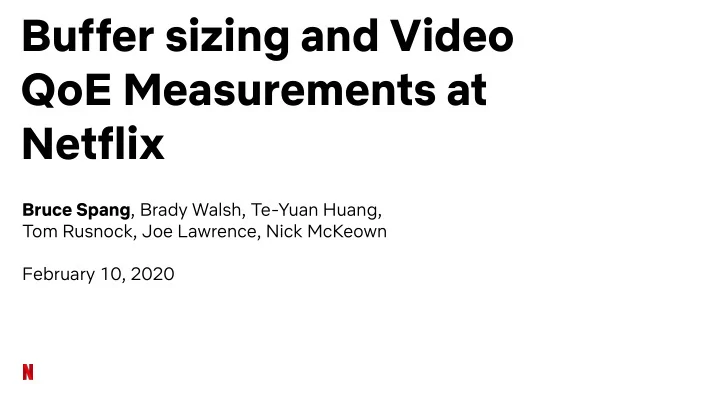

Buffer sizing and Video QoE Measurements at Netflix Bruce Spang , Brady Walsh, Te-Yuan Huang, Tom Rusnock, Joe Lawrence, Nick McKeown February 10, 2020
What are we talking about?
What are we talking about? Buffer Server 1 ISP Server 2 …
How big should a buffer be? Too big: packets wait for too long Too small: too many packets thrown away
“A buffer should be at least one BDP” [Villamizar, Song 1994]
“A buffer should be at least one BDP” [Villamizar, Song 1994] BDP=Bandwidth x Delay # of packets in a link for full utilization
“A buffer should be at least one BDP” [Villamizar, Song 1994] BDP=Bandwidth x Delay # of packets in a link for full utilization Congestion Window Time
“A buffer should be at least one BDP” [Villamizar, Song 1994] BDP=Bandwidth x Delay # of packets in a link for full utilization Congestion Window Loss happens when link and buffer are full BDP + B Time
“A buffer should be at least one BDP” [Villamizar, Song 1994] BDP=Bandwidth x Delay # of packets in a link for full utilization Congestion Window Loss happens when link and buffer are full BDP + B ½(BDP + B) TCP stops sending until ½ (BDP+B) packets received Time
“A buffer should be at least one BDP” [Villamizar, Song 1994] BDP=Bandwidth x Delay # of packets in a link for full utilization Congestion Window Loss happens when link and buffer are full } BDP + B Buffer needs to hold this many packets ½(BDP + B) TCP stops sending until ½ (BDP+B) packets received Time
How big should a buffer be? BDP: Villamizar and Song 1994 BDP/√n: Appenzeller, McKeown, Keslassy 2004 O(n): Dhamdhere, Jiang, Dovrolis 2005 O(1): Enachescu, Ganjali, Goel, McKeown, Roughgarden 2006
Which is correct?
It’s complicated
1. TCP New Reno (mostly) behaves as expected 2. Video performance varies 3. Real routers complicate this story
Our Experiment
Catalog servers Uses spinning disks, cheaply stores entire catalog
Offload servers Use SSDs to serve top ~30% of content faster
These three racks are called a stack
…and this Make this one large buffer small…
1. TCP New Reno (mostly) behaves as expected 2. Video performance varies 3. Real routers complicate this story
Large buffer has higher latency during congested hour
Sometimes the large buffer has much higher latency
Large buffer has lower loss during congested hour
1. TCP New Reno (mostly) behaves as expected 2. Video performance varies 3. Real routers complicate this story
Good buffer size: + Fewer rebuffers + Better video quality + Videos start faster Bad buffer size: - More rebuffers - Worse video quality - Videos start slower
Good buffer size: + Fewer rebuffers + Better video quality + Videos start faster - Videos start slower } Bad buffer size: This happens - More rebuffers when buffer is - Worse video quality too large or too small.
Site #2: A smaller buffer is better Reducing the buffer from 500MB to 25MB -15.6% decrease in sessions with a rebuffer -5.3% decrease in low quality video -13.5% decrease in play delay
Site #3: A smaller buffer is better Reducing the buffer from 500MB to 50MB -22.1% decrease in sessions with a rebuffer -7.0% decrease in low quality video -14.8% decrease in play delay
Site #1: A smaller buffer is worse Reducing the buffer from 500MB to 50MB +46.3% increase in sessions with a rebuffer +5.7% increase in low quality video -5.9% decrease in play delay
1. TCP New Reno (mostly) behaves as expected 2. Video performance varies 3. Real routers complicate this story
Large buffer has higher latency during congested hour
Remember how the large buffer has much higher latency…
Servers have different very latency distributions Min RTT (ms)
What I imagined Buffer Server 1 ISP Server 2 …
What I imagined LIES! Buffer Server 1 ISP Server 2 …
Line card #1 Line card #2 Line card #3 Line card #4
VOQ #1 VOQ #2 VOQ #3 VOQ #4 VOQ #5 VOQ #6 VOQ #7 VOQ #8
Buffer architecture “Offload” VOQ Server #1 2/3 Server #2 100Gbps ISP “Catalog” VOQ 1/3 Server #3
Traffic is fairly split when load is equal “Offload” VOQ 40 Gbps 40 Gbps 67 Gbps 100Gbps ISP “Catalog” VOQ 33 Gbps 40 Gbps
When one VOQ offers less than its fair share, it sees no congestion “Offload” VOQ 50 Gbps 50 Gbps 90 Gbps 100Gbps ISP “Catalog” VOQ 10 Gbps 10 Gbps No delay!
VOQs explain the RTT differences This VOQ is served faster This VOQ is served slower This VOQ is all over the place Min RTT (ms)
Switches prioritize long-tail content
Switches prioritize long-tail content Same latency during uncongested hours
Switches prioritize long-tail content Same latency during uncongested hours Popular content Long-tail content is congested not congested
New scheduling algorithm! “Offload” VOQ Server #1 Load-dependent Server #2 100Gbps ISP “Catalog” VOQ Load-dependent Server #3
New scheduling algorithm is more consistent Default scheduling algorithm
1. TCP New Reno (mostly) behaves as expected 2. Video performance varies 3. Real routers complicate this story
How big should a buffer be?
Thanks! For more details, please see: https://brucespang.com/papers/netflix-buffer-sizing.pdf
Recommend
More recommend